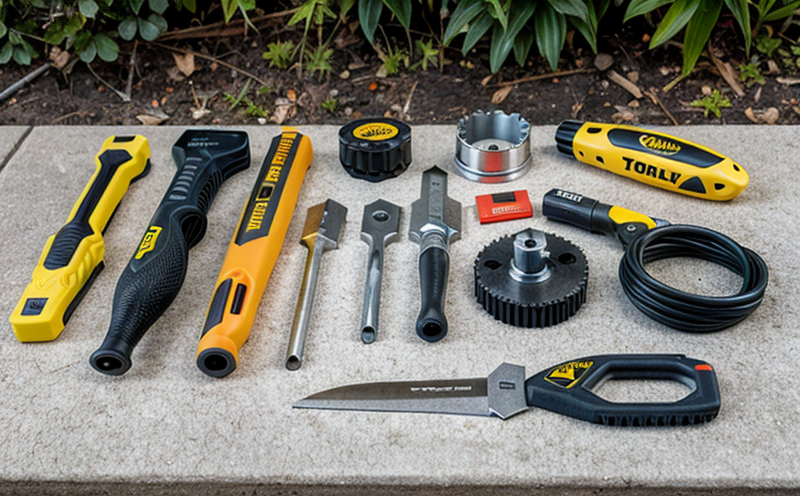Handle Strength Testing in Hand Tools
Handle strength testing is a critical process within the consumer products and product safety sector that ensures hand tools meet stringent standards of durability and user safety. This test evaluates the structural integrity of tool handles, focusing on their ability to withstand applied loads without compromising functionality or posing a risk to the user. Compliance with international standards such as ISO 7250-1:2016 is essential for manufacturers aiming to ensure product quality and consumer safety.
The testing methodology involves applying controlled forces to simulate real-world conditions, such as those encountered during routine use or accidental overloading. This procedure helps identify any potential weaknesses in the design that could lead to premature failure. The test setup typically includes a loading apparatus capable of exerting precise force values while monitoring deflection and deformation.
For quality managers overseeing the production process, handle strength testing serves as an indispensable tool for maintaining consistent product performance across batches. By identifying faulty products early in the manufacturing cycle, it becomes possible to implement corrective actions promptly, thereby reducing waste and improving overall efficiency. Compliance officers can leverage this information to ensure adherence to regulatory requirements, while R&D engineers benefit from insights that allow them to optimize designs further.
From a broader perspective, handle strength testing plays an integral role in safeguarding end-users by preventing accidents caused by tool failures. Accidents involving hand tools are often reported as hazardous incidents due to improper grip or sudden release of the tool under unexpected loads. By subjecting handles to rigorous inspection procedures, manufacturers can mitigate these risks significantly.
In summary, handle strength testing is not merely a technical requirement but also a vital component in ensuring product reliability and user satisfaction. It underscores the importance of adhering strictly to industry standards while fostering continuous improvement through ongoing evaluation and refinement.
- Ensures compliance with international safety regulations
- Improves product durability and reduces warranty claims
- Safeguards against potential accidents caused by tool failures
- Promotes user confidence in purchased products
Benefits
The benefits of incorporating handle strength testing into your quality assurance program extend far beyond mere compliance with legal requirements. For consumers, it translates directly into enhanced safety and peace of mind when using hand tools in various settings—from home DIY projects to professional construction work.
From a business standpoint, implementing robust testing protocols can lead to increased customer loyalty and brand reputation. Satisfied customers are more likely to recommend your products to others, which in turn fosters long-term growth and profitability.
In addition, adhering to strict quality control measures helps protect against product recalls and associated costs. A single recall can be financially devastating for a company, especially if multiple units have been distributed across different markets. By investing early in thorough testing practices, businesses can avoid such costly pitfalls altogether.
Moreover, participation in industry benchmarking initiatives becomes more feasible when equipped with reliable data from comprehensive tests like these. Such benchmarks serve as valuable reference points that enable companies to stay competitive and innovative within their respective fields.
Industry Applications
In the realm of DIY tools & hardware products testing, handle strength testing holds particular significance given its direct impact on user experience and safety. This form of assessment is especially pertinent for power drills, screwdrivers, wrenches, pliers, hammers, and other manual tools commonly used in both residential and commercial environments.
For instance, when evaluating a power drill's handle, the focus lies primarily on assessing its resistance to torque-induced stresses during continuous operation. Similarly, for wrenches or pliers designed for heavy-duty applications, the emphasis shifts towards ensuring that even under extreme conditions (such as accidental drops), they maintain their structural integrity without compromising usability.
These tests are equally important for manufacturers of safety equipment such as fire extinguishers and protective gear where the slightest compromise in material quality could result in severe consequences. By integrating handle strength testing into their manufacturing processes, companies can significantly enhance product reliability and user confidence.
Why Choose This Test
- Precise measurement of handle durability under various loading scenarios
- Comprehensive evaluation of material properties and design robustness
- Identification of potential weaknesses early in the production cycle
- Inclusion in international standards for enhanced credibility
- Data-driven decision-making supporting continuous improvement efforts
Choosing handle strength testing ensures that your hand tools meet stringent safety criteria, enhancing user confidence and satisfaction. With accurate data on material performance under stress, you can make informed decisions about design modifications or component substitutions.
The test provides a reliable benchmark against which future iterations can be compared, fostering innovation while ensuring consistent quality levels. Additionally, by participating in industry-wide assessments using standardized procedures, companies demonstrate their commitment to excellence and reliability.





